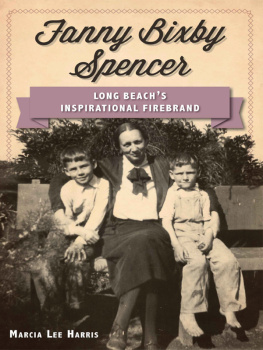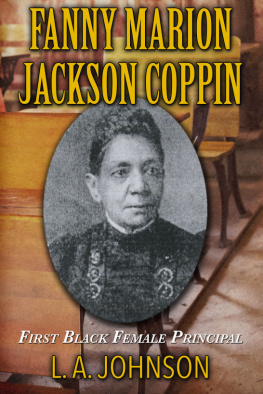

Fanny Bixby in 1900. Rancho Los Cerritos Collection.

Published by The History Press
Charleston, SC 29403
www.historypress.net
Copyright 2013 by Marcia Lee Harris
All rights reserved
First published 2013
e-book edition 2013
Manufactured in the United States
ISBN 978.1.61423.856.0
Library of Congress CIP data applied for.
print edition ISBN 978.1.60949.875.7
Notice: The information in this book is true and complete to the best of our knowledge. It is offered without guarantee on the part of the author or The History Press. The author and The History Press disclaim all liability in connection with the use of this book.
All rights reserved. No part of this book may be reproduced or transmitted in any form whatsoever without prior written permission from the publisher except in the case of brief quotations embodied in critical articles and reviews.
This book is dedicated to my father, Marvin C. Sokol, who always said, Be who you are, and encouraged me to be an independent woman like Fanny Bixby Spencer.
Contents
Authors Note
Thank you for choosing my book and starting your journey to discover Fanny Bixby Spencer.
I have portrayed Fanny Bixby Spencer as a living history character for ten years. I had the privilege of reading her letters, scrapbooks, manuscripts and booklets, as well as newspaper articles about her. I investigated family members and historic sites and listened to an oral interview about Fanny given by her daughter. Some finer details in Fannys life were hard to discover. History also depends on different viewpoints. His story does not always record her story. Women born in the 1800s were rarely written about. Throughout the years, stories seem to change, and the memory fades. Fanny wrote her childhood life story in 1929 at age fifty, so there was a big gap from 1879 onward.
Michael Bywaters Lost World notes, One of the rules of history is that people do not write about what is too obvious to mention. And so the information, having never been recorded, is now lost forever. I found this to be true in researching the finer details about Fanny. I felt the information about her life that I did discover should be compiled and shared. Phrases and sentences attributed to Fanny are her exact words. I would welcome hearing from anyone who has additional information about Fanny Bixby Spencer, but for now, see how the events in Fannys childhood influenced her adult life and determine your own opinion of Fanny Bixby Spencer.
May the pages of my story
inspire you to see,
how the past has made the present and all about Fanny,
that has yet to be
Introduction
Finding Fascinating Fanny
Who was Fanny Bixby Spencer? Did she break rules or make rules? Fanny was a woman who never sought fame or recognition, and she did so much at a time in history when women did not venture out. Was she fascinating or frustrating? Truly, Fanny was quite a complex person. Her experiences and circumstances helped make her the person she becamea female with many firsts, fights and feelings. Her life was filled with mystery.
And though I fail and die.
And am forgot,
The truth for which I was oppressed
And struck
Gains in momentum and velocity
And drives ahead, defensive in itself,
Resistant, penetrating, free, alive.
This epitaph was to be written on Fannys gravestone, but it is a mystery just where she ended up after her April 3, 1930 final goodbye. No stone exists today.
Our lives are measured not by birthdays but by the events that fall between them. It is the dash in between the dates of birth and death that represents what is important. What happened between 1879 and 1930? Who was Fanny Bixby Spencer?
Fanny Bixby often quoted from Psalms, saying, We spend our lives as a tale that is told. Now her story must be told. Lifes little twists and turns can be strong and mysterious, but they lead to our destiny. Many things that happen to you as a child shape the adult you become.

Two Moreton Bay fig trees planted in the 1870s merged into one. Rancho Los Cerritos Historic Site, Long Beach, California. Infrared image courtesy of Eliza Bon 2000.
The oak is like an aged woman, standing tall, stately and dignified. The willow tree, on the other hand, bends with the wind. Fanny Bixby was both an oak and a willow. She stood up for her beliefs, but she was also capable of bending with the wind and providing shelter. Fanny wept for many and provided shelter for those less fortunate. The Moreton Bay fig tree planted at her first home still stands, its branches and roots spreading in every direction. Fannys life similarly branched out in many ways. This beautiful tree has endured all kinds of wind and weather. It has grown and changed over time as the stories of Fanny Bixby Spencer have evolved through the years.
Like this tree, Fanny branched out, standing tall in the community. She had a lifelong love of trees, nature and all people. Her first home was the adobe residence that had more than one thousand bricks per room. Fanny ended up being involved in more than one thousand things in her lifetime, all the while illuminating many lives and donating time, treasures and comfort. She affected people in a positive way, making lives better, helping the poor, assisting cities, donating land, establishing a library, working in law enforcement, being a suffragette in order to move womens issues forward and much more. Fanny was an inspiration to others.
Part I
The Early Years
THE STORY BEGINS
The fall leaves were almost gone, and it was a frisky first Thursday in the month of November outside the house that Jotham and Margaret Bixby were leasing in Los Angeles. There, on November 6, 1879, Fanny Weston Bixby was born. She was the second to last child born into the Bixby family, but she grew to be the first of many things, including one of the first policewomen in the country. Fanny was named after her fathers mother, Fanny Weston, so she became Fanny Weston Bixby.
Like the fallen leaves, Fanny has fallen from the public memory, but as one of the first policewomen and one of the founders of the city of Costa Mesa, California, she should not be Forgotten Fanny.
Fanny gave herself to society and was a kindred soul, tracing her roots from her father, Jotham Bixby. He arrived in California from Maine in 1852, during the gold rush days. He arrived in the mining town of Volcano, where his brother, Lewellyn, and two cousins, Benjamin and Thomas Flint, had purchased a butcher shop. The group recognized the value of supplying the miners with provisions rather than wading through icy streams hoping to be lucky in finding gold. In 1853, the Flint brothers and Lewellyn Bixby traveled back to Maine and returned with a flock of sheep. Along the way, they formed Flint, Bixby and Company. Jotham took a job helping to manage the growing flocks.
Lewellyn Bixby, on a journey home to Maine in 1859, married Sarah Hathaway, daughter of Reverend George W. Hathaway of Skowhegan, a town near the Bixby hometown of Norridgewock. When Jotham went home to visit his family in 1862, he stopped to pass along his brothers greetings to the Hathaway family. There he met Margaret Hathaway at the gate and lost his heart. Arrangements were made, and she, properly chaperoned, followed him to California, where they married. The couple started their life together at the Rancho San Justo in Monterey County, California.
Next page
















